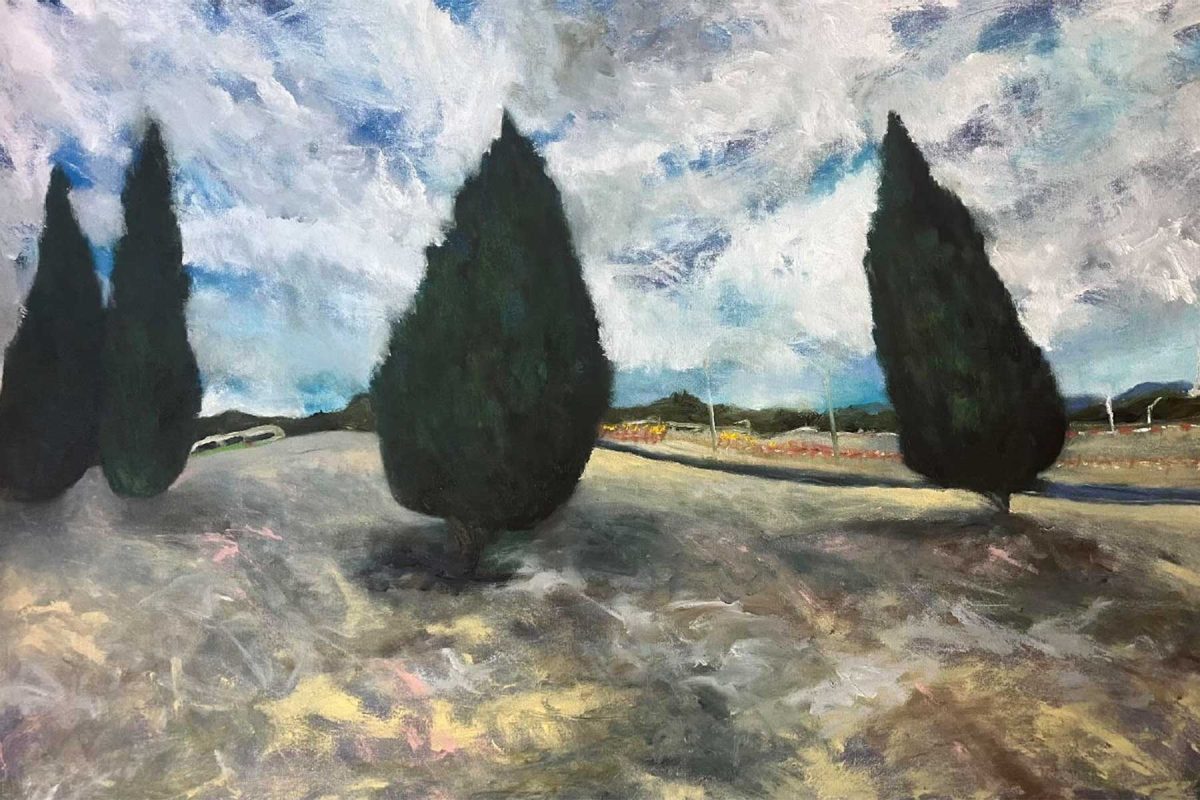Like sands through the hourglass, these are the trees of our lives…
Simone Annis is a passionate artist who likes to paint amid the chaos of running an e-bike business.
For the past 15 years, she has managed the business, raised three children, and delighted in Canberra’s natural habitat, carving out moments in the day to commit what she sees to canvas.
Her current exhibition, entitled “A street tree named desire”, is showing at The Link in Ginninderry until 14 April.
Following on from her sell-out second show last year, Simone tells a story of place and belonging, in the suburban landscape that she inhabits daily.
“Like the trees, I’ve laid down roots.”
The artist lives a dichotomous life, having completed an MBA (Strategic Operations Management) from Charles Stuart University “a long time ago” and a BA in Visual Arts (Painting) from the Australian National University “a very, very, long, long time ago”.
Managing Switched on Cycles during the day means Simone generally paints between customers. The pay-off when business is quiet is that she gets to put paint to paintbrush.
“The advantages of running a business from home I guess is that my office/studio contains both bike parts and painting supplies. Lucky I’m good with chaos and multi-tasking! I also paint a lot on weekends. I like to be busy and useful so having a number of projects and paintings going at once suits me quite well.”
An exhibition presents an opportunity to view her work through a thematic lens and with critical eyes, as well as allowing Simone to sell her work to the public and clear space for new work.

“A street tree named desire” includes a selection of recent paintings based on street trees and the related ‘desire lines’ theme.
“The landscape, and elements within the landscape, such as trees, rivers, buildings, roads, and pathways, tells us a story of place and belonging, and by inference, of who we, collectively, are.”
Simone uses her theme to explore the suburban landscape that she (and others) inhabit daily.
“Through looking for beauty in everyday urban green spaces, I get a sense of myself that also affirms who I am. Like the trees, I’ve laid down roots.”
In urban and transport planning ‘desire lines’ refer to the unofficial paths that collective feet make through the landscape over time.
“These well-trodden paths are both subversive, being illicit, and conversely, the path of least resistance. Desire Lines are paths that form themselves and are evidence of both humanity and the impact of humans in the environment.”

Simone notes that desire lines are often found under street trees, as we naturally gravitate to walking under the trees.
“Street trees ground us in a place but go unnoticed as backdrops to most people’s lives and experiences. Fashions change: houses go up, get renovated and pulled down but, for the most part, the trees stay the same and grow old more gracefully.”
Fashion in landscape architecture has also changed: from the understory of respectability and colonisation implied by the oaks, elms and conifers of the leafy inner city to the smattering of pocket parks containing majestic remnant gumtrees surrounded by native grasses in the new outer suburbs.
“Some trees, like the people, are in place, out of place. Other trees remind us that, the landscape (and indigenous culture) always was and always will be.”
Simone states that copious research says time spent with trees help us stay healthier and happier and another theme is that trees also help to mitigate the impacts of global warming.
From the paperbarks of Horseshoe Bay (on Magnetic Island) to the river gums of Quilpie (outback Queensland) to the conifers outside the Ainslie IGA, Simone’s exhibition has a tree for every taste.
“A street tree named desire” has its official opening on Saturday 9 March, from 12pm – 2pm, and is showing at The Link until 14 April. Take a virtual tour.



